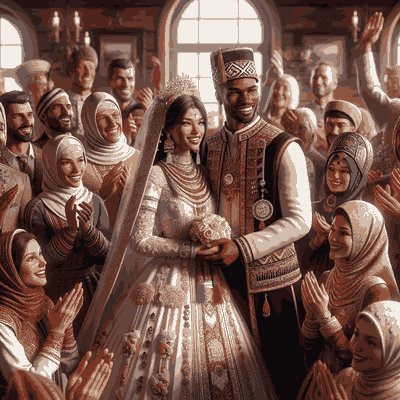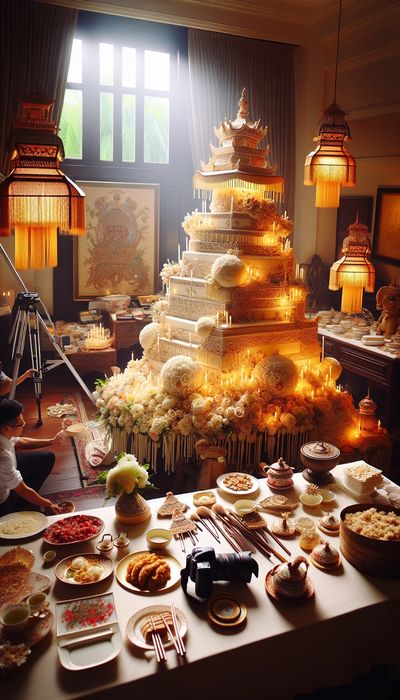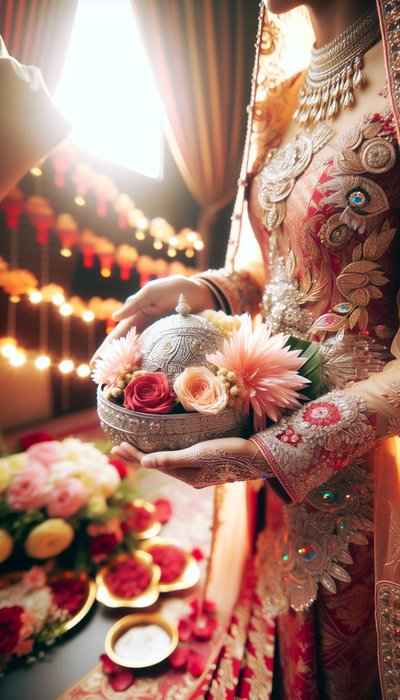Slovenia Wedding Traditions Complete Guide for Modern Couples
What Are Slovenian Wedding Traditions?
Slovenian wedding traditions are multi-day celebrations that blend Central European customs with distinctive regional practices, typically lasting 2-3 days and involving 150-300 guests from both families. These culturally rich ceremonies encompass pre-wedding rituals like zarokazah-ROH-kahengagement, the mandatory civil ceremony, religious services, and distinctive reception customs including žaganje hlodaZHAH-gah-nyeh HLOH-dahlog sawing and kraja nevesteKRAH-yah neh-VEH-stehbride stealing.
Overview of Slovenian Wedding Process
- 12 months before: Zaroka (si_zaroka) formal engagement ceremony
- 6 months before: Venue booking and dekliščinadek-LEESH-chee-nah/fantovščinafan-TOHV-shchee-nahsi_dekliščina-fantovščina planning
- 3 months before: Snubitevsnoo-BEE-tevsi_snubitev formal asking ceremony
- 1 month before: Final preparations and pričePREE-chehsi_priče selection
- Wedding week: Civil ceremony at upravna enotaoo-PRAHV-nah eh-NOH-tahsi_upravna-enota
- Wedding day: Religious ceremony and poročno slavjepoh-ROHCH-noh SLAHV-yehsi_poročno-slavje
- Day after: Popravno slavjepoh-PRAHV-noh SLAHV-yehsi_popravno-slavje after-party
Pre-Wedding Traditions and Ceremonies

Zaroka: The Formal Engagement Process
Zarokazah-ROH-kah (si_zaroka) is a formal engagement tradition that initiates the marriage process, typically occurring 6-12 months before the wedding and involving 20-30 family members from both sides.
Cost and Duration
- Traditional cost: €500-€1,500500 to 1,500 euros
- Duration: Single evening celebration (4-6 hours)
- Participants: 20-30 close family members
- Location: Usually at bride’s family home
The Zaroka Process
- Initial meeting: Groom’s parents contact bride’s family through starešinastah-REH-shee-nahsi_starešina intermediary
- Formal gathering: Both families meet for ceremonial dinner with traditional foods
- Ring exchange: Simple gold bands placed on right hands (€200-€500 per ring)
- Blessing ritual: Parents offer bread, wine, and honey to seal engagement
Regional Variations
Gorenjska zaroka (si_gorenjska-zaroka) includes accordion music and alpine flower decorations, with celebrations often featuring local žganjeZHGAH-nyehsi_žganje schnapps costing €30-50 per bottle.
Primorska approach (si_primorska-zaroka) differs by incorporating local wines and olive branch blessings, with coastal families often hosting outdoor celebrations.
Modern Adaptations
Contemporary couples often combine traditional family meetings with modern elements:
- Professional photography (€300-€800)
- Restaurant venues instead of home celebrations (€50-€100 per person)
- Diamond rings alongside traditional gold bands
- Shortened timeline (3-6 months vs traditional 12 months)
Snubitev: The Formal Asking Ceremony
Snubitevsnoo-BEE-tev (si_snubitev) is a ceremonial tradition where the groom officially requests the bride’s hand, typically occurring 1-3 months before the wedding and involving male family members.
Cost and Duration
- Traditional cost: €200-€500200 to 500 euros
- Duration: 2-3 hours
- Participants: 5-10 male relatives
- Gifts: Symbolic items worth €100-€300
The Snubitev Protocol
- Preparation: Groom and priča (si_priča) prepare formal speeches
- Arrival ceremony: Men bring traditional gifts of bread and salt
- Formal request: Scripted conversation with bride’s parents
- Acceptance ritual: Sharing of ceremonial wine upon agreement
Regional Variations
Štajerska snubitev (si_štajerska-snubitev) features elaborate poetic speeches and wine from local vineyards, with ceremonies often including traditional musicians (€200-€400).
Prekmurje tradition (si_prekmurje-snubitev) incorporates special bread called vrtanikvur-TAH-neeksi_vrtanik and distinctive Hungarian-influenced rituals.
Dekliščina and Fantovščina: Bachelor and Bachelorette Parties
Dekliščinadek-LEESH-chee-nah (si_dekliščina) is a bachelorette celebration marking the bride’s farewell to single life, while fantovščinafan-TOHV-shchee-nah (si_fantovščina) serves the same purpose for grooms, typically occurring 2-4 weeks before the wedding.
Cost and Duration
- Traditional cost: €150-€500 per person ($165-$550 USD)
- Modern cost: €300-€1,000 per person for weekend trips
- Duration: Single evening (traditional) or 2-3 day weekend (modern)
- Participants: 10-20 close friends
Traditional Activities
- Symbolic farewell: Friends present advice through songs and stories
- Skill testing: Grooms demonstrate household abilities
- Wine tasting: Especially in Primorska region (€50-€100 per person)
- Traditional games: Including mock “kidnapping” preparations
Wedding Ceremony Traditions

Civilna Poroka: The Mandatory Civil Ceremony
Civilna porokatsee-VEEL-nah poh-ROH-kah (si_civilna-poroka) is a legally required civil ceremony conducted by a matičarmah-TEE-charsi_matičar registrar, typically lasting 15-30 minutes and preceding any religious ceremony.
Cost and Requirements
- Official fee: €50-€10050 to 100 euros
- Special venue fee: €200-€1,000 for castles or historic sites
- Documentation: €30-€50 for required paperwork
- Witnesses: Minimum 2 required (pričePREE-cheh)
Civil Ceremony Process
- Document submission: Application at upravna enotaoo-PRAHV-nah eh-NOH-tah 30 days prior
- Venue selection: Registry office or approved locations
- Vow exchange: Standard civil vows in Slovenian
- Ring ceremony: Optional but commonly included
- Certificate signing: Legal documentation completed
Modern Venue Options
Contemporary couples increasingly choose special locations:
- Ljubljana Castle: €500-€1,500 rental fee
- Lake Bled venues: €800-€2,000
- Coastal locations: €400-€1,200
- Mountain settings: €300-€800
Religious Wedding Ceremonies
Poročna mašapoh-ROHCH-nah MAH-shah (si_poročna-maša) is a Catholic wedding mass that represents the spiritual union, typically lasting 45-60 minutes and involving 100-300 guests.
Cost and Duration
- Church donation: €200-€500200 to 500 euros
- Musician fees: €150-€400
- Flower decorations: €300-€800
- Duration: 45-60 minutes (Catholic), 30-45 minutes (Protestant)
Catholic Ceremony Elements
- Processional: Traditional organ music or regional folk instruments
- Scripture readings: Often in Slovenian and Latin
- Unity candle: SvečaSVEH-chahsi_sveča lighting ceremony
- Marian devotion: Special prayers to Virgin Mary
- Final blessing: Including regional benedictions
Regional Religious Variations
Prekmurje Protestant tradition (si_evangeličanska-poroka) features shorter ceremonies with more personalized elements and Hungarian influences.
Primorska Catholic customs include blessing with olive branches and incorporation of Italian liturgical elements.
Priče: The Wedding Witnesses Tradition
Priče (si_priče) are official wedding witnesses who serve legal and ceremonial roles, traditionally chosen for their exemplary marriages and wisdom.
Responsibilities and Costs
- Ceremonial duties: Ring holding, document signing
- Financial contribution: Often €500-€2,000 gift to couple
- Attire: Special sashes or boutonnieres (€50-€100)
- Reception roles: Speech giving, ceremony coordination
Selection Process
- Traditional criteria: Married couples with strong relationships
- Modern choices: Close friends or siblings regardless of marital status
- Number: Exactly 2 for legal requirements
- Honorary priče: Additional unofficial witnesses (4-6 people)
Kruh in Sol: The Bread and Salt Welcome
Kruh in solkrooh een sohl (si_kruh-in-sol) is a symbolic greeting ceremony where newlyweds share bread and salt, typically occurring immediately after the ceremony and lasting 5-10 minutes.
Symbolic Elements and Costs
- Special bread: Pogačapoh-GAH-chahsi_pogača or poticapoh-TEE-tsahsi_potica - €30-€80
- Ceremonial salt: In decorative container - €20-€50
- Welcome wine: Local variety - €30-€100
- Decorative tray: Traditional wooden or ceramic - €50-€150
The Greeting Process
- Parent preparation: Mothers ready bread and salt on decorated tray
- Couple arrival: Greeted at reception venue entrance
- Bread breaking: Each tears piece and dips in salt
- Wine toast: Shared cup symbolizing unity
- Guest participation: Sometimes extended to all attendees
Regional Bread Variations
Prekmurje vrtanikvur-TAH-neek (si_vrtanik) is a special wedding bread with distinctive braided patterns costing €50-€100.
Gorenjska pogača includes mountain herbs and costs €40-€80, often decorated with alpine motifs.
Wedding Reception and Celebration Customs

Žaganje Hloda: The Traditional Log Sawing Ceremony
Žaganje hlodaZHAH-gah-nyeh HLOH-dah (si_žaganje-hloda) is a symbolic teamwork challenge where newlyweds saw through a log together, typically lasting 10-15 minutes and performed outside the reception venue.
Cost and Setup
- Decorated log: €50-€15050 to 150 euros
- Two-person saw: €30-€80 (often family heirloom)
- Sawhorses: €50-€100 rental
- Photography: Prime photo opportunity
The Sawing Process
- Log presentation: Decorated with flowers and couple’s names
- Instruction phase: Guests offer humorous advice
- Sawing demonstration: Couple must coordinate movements
- Completion celebration: Sawdust collected as keepsake
- Wood piece distribution: Given to witnesses as memento
Symbolic Interpretations
The tradition represents overcoming obstacles together, with successful completion indicating good teamwork. Regional variations include different wood types: oak in Štajerska (€100-€200), pine in Gorenjska (€50-€100), and sometimes olive wood in Primorska (€150-€300).
Poročno Slavje: The Traditional Wedding Feast
Poročno slavjepoh-ROHCH-noh SLAHV-yeh (si_poročno-slavje) is an elaborate multi-course wedding reception feast that typically lasts 6-8 hours and costs €80-€150 per guest.
Traditional Menu Structure and Costs
- Welcome drinks: ŽganjeZHGAH-nyeh or wine - €5-€10 per person
- Soup course: Goveja juhagoh-VEH-yah YOO-hahsi_goveja-juha - €8-€12 per person
- Cold appetizers: Regional meats and cheeses - €15-€25 per person
- Main courses: 2-3 options - €30-€50 per person
- Dessert table: Including poticapoh-TEE-tsah - €10-€20 per person
- Midnight meal: Goulash or soup - €8-€15 per person
Regional Feast Specialties
Prekmurje gibanicagee-BAH-nee-tsah (si_gibanica) is a layered pastry dessert costing €40-€80 per cake serving 20-30 guests.
Štajerska bogračBOH-grahch (si_bograč) is a hearty stew served as midnight meal for €10-€15 per person.
Primorska pršutpur-SHOOT (si_pršut) features local prosciutto platters costing €20-€30 per person.
Modern Feast Adaptations
Contemporary weddings blend traditional and international cuisine:
- Shortened to 4-5 courses (€60-€100 per person)
- Vegetarian options now standard (€50-€80 per person)
- Interactive food stations (€15-€25 per person additional)
- Traditional elements remain in desserts and midnight meal
Kraja Neveste: The Bride Stealing Tradition
Kraja nevesteKRAH-yah neh-VEH-steh (si_kraja-neveste) is a playful kidnapping tradition where friends “steal” the bride during reception, typically occurring 2-3 hours into celebration and lasting 30-60 minutes.
Traditional Protocol and Costs
- Ransom payment: Drinks for kidnappers - €50-€200
- Multiple locations: 2-3 nearby bars or cafes
- Transportation: Decorated cars - €100-€300
- Entertainment value: Creates reception intermission
The Kidnapping Process
- Distraction phase: Friends distract groom during dancing
- Bride removal: Quietly escorted to waiting vehicle
- Location hopping: Visit 2-3 predetermined spots
- Groom’s search: Must find bride with clues
- Ransom negotiation: Groom buys rounds or performs tasks
Regional Variations
Urban kidnappings often involve trendy bars with ransoms of craft cocktails (€8-€15 per drink).
Rural traditions may include tractor transport and village pub visits (€3-€5 per beer).
Nevestin Venec: The Bridal Crown and Unveiling
Nevestin venecneh-VEH-steen VEH-nets (si_nevestin-venec) is a bridal crown tradition culminating in midnight unveiling ceremony that marks transition to married life, lasting 20-30 minutes.
Crown Types and Costs
- Fresh flower crown: €80-€20080 to 200 euros
- Ivy wreath: €50-€100 (traditional choice)
- Myrtle crown: €60-€120 (fertility symbol)
- Modern tiara: €100-€500
The Unveiling Ceremony
- Midnight gathering: Guests form circle around bride
- Special music: Traditional unveiling songs
- Crown removal: By mother or eldest married woman
- Scarf placement: RutaROO-tahsi_ruta symbolizing married status
- Crown passing: To unmarried woman predicting next bride
Modern Interpretations
Contemporary ceremonies focus on celebration rather than status change:
- Choreographed dances replace solemn rituals
- Veil tossing similar to bouquet throwing
- Photo opportunities emphasized
- Symbolic rather than literal transformation
Obhod: The Traditional Money Dance
ObhodOHB-hohd (si_obhod) is a money collection dance where guests pay to dance with newlyweds, typically raising €500-€3,000 for the couple’s future.
Dance Protocol and Contributions
- Standard contribution: €5-€50 per dance ($5.50-$55 USD)
- Dance duration: 30-60 seconds per guest
- Collection method: Special apron or decorated box
- Total duration: 30-45 minutes
The Money Dance Process
- Announcement: Band leader explains tradition
- Line formation: Male guests for bride, female for groom
- Payment collection: Money pinned or placed in container
- Brief dance: Each guest gets personal moment
- Thank you: Couple acknowledges each contributor
Regional Variations
Štajerska obhod features polka music with typical contributions of €10-€20 per person.
Primorska tradition includes Italian-influenced music with contributions of €20-€50 per dance.
Regional Variations

Gorenjska Alpine Wedding Traditions
Gorenjska wedding customs (si_gorenjske-poročne-šege) are alpine region traditions featuring mountain elements, typically involving 200-400 guests and costing €15,000-€30,000 total.
Distinctive Regional Elements
- Frajtonaricafry-toh-NAH-ree-tsah music: Traditional flute - €200-€400 for musicians
- Alpine decorations: Edelweiss and mountain flowers - €300-€600
- Traditional costumes: Rental €100-€300 per outfit
- Horse carriages: €500-€1,500 for procession
- Mountain venues: €2,000-€5,000 rental
Gorenjska Specialties
Ajdovi žganciAY-doh-vee ZHGAHN-tsee (si_ajdovi-žganci) is buckwheat porridge served as traditional side dish for €5-€8 per person.
Gorenjska poticapoh-TEE-tsah features walnut filling with honey, costing €40-€60 per roll serving 15-20 guests.
Primorska Coastal Wedding Customs
Primorska wedding traditions (si_primorske-poročne-šege) are Mediterranean-influenced celebrations emphasizing wine and seafood, typically lasting 8-10 hours.
Coastal Tradition Costs
- Vineyard venues: €3,000-€8,000 rental
- Seafood menu: €100-€200 per person
- Local wine service: €30-€80 per person
- Olive branch decor: €200-€400
- Italian musicians: €500-€1,500
Primorska Specialties
Briška rebulaBREESH-kah reh-BOO-lah (si_briška-rebula) is a traditional wedding wine costing €15-€40 per bottle.
Kraški pršutKRAHSH-kee pur-SHOOT platters feature local prosciutto at €25-€35 per person.
Prekmurje and Štajerska Eastern Traditions
Prekmurje wedding customs (si_prekmurske-poročne-šege) are Pannonian-influenced traditions featuring elaborate bread ceremonies and Hungarian elements, typically involving 300-500 guests.
Eastern Region Costs
- Gibanicagee-BAH-nee-tsah cakes: €50-€100 per cake
- BogračBOH-grahch preparation: €800-€1,500 for 200 guests
- Folk ensembles: €600-€1,500
- Traditional embroidery: €200-€500 per outfit
- Extended celebrations: €20,000-€40,000 total
Prekmurje Specialties
Vrtanikvur-TAH-neek bread (si_vrtanik) is ceremonial wedding bread with braided designs costing €60-€120.
Prekmurska gibanica is a nine-layer pastry costing €60-€100 per cake serving 30 guests.
How much does a typical Slovenian wedding cost?
The total cost of a Slovenian wedding ranges from €10,000-€40,00010,000 to 40,000 euros, with the average being €20,000-€25,000 for 150-200 guests. Major expenses include venue rental (€2,000-€5,000), catering at €80-€150 per person, photography and videography (€1,500-€3,500), and music entertainment (€800-€2,000). Regional variations affect pricing significantly - Gorenjska mountain weddings tend toward the higher end due to venue costs, while rural Prekmurje celebrations may cost less but involve more guests. The poročno slavjepoh-ROHCH-noh SLAHV-yehsi_poročno-slavje feast represents the largest single expense at 40-50% of the total budget. Modern couples often reduce costs by limiting guest lists to 100-150 people and choosing single-day rather than multi-day celebrations.
What is the traditional Slovenian wedding timeline?
Traditional Slovenian weddings span 2-3 days, though modern celebrations often condense to a single day. The process begins with zarokazah-ROH-kahsi_zaroka engagement 6-12 months before the wedding. The wedding week starts with the civilna porokatsee-VEEL-nah poh-ROH-kahsi_civilna-poroka civil ceremony, legally required and lasting 15-30 minutes. The main wedding day begins with morning preparations, followed by an optional religious ceremony (45-60 minutes), the kruh in solkrooh een sohlsi_kruh-in-sol bread and salt greeting, and the reception lasting 6-8 hours. Key reception moments include žaganje hlodaZHAH-gah-nyeh HLOH-dahsi_žaganje-hloda log sawing, dinner service, kraja nevesteKRAH-yah neh-VEH-stehsi_kraja-neveste bride stealing, and midnight unveiling ceremony. The following day features popravno slavjepoh-PRAHV-noh SLAHV-yehsi_popravno-slavje, a casual gathering for close family and friends lasting 4-6 hours.
Who traditionally pays for a Slovenian wedding?
Historically, Slovenian wedding costs were shared between both families, with specific responsibilities divided by tradition. The bride’s family typically covered the poročno slavje (si_poročno-slavje) reception feast and venue, while the groom’s family paid for drinks, music, and transportation. Modern Slovenian couples increasingly finance their own weddings, with parents contributing specific elements rather than covering all costs. The obhodOHB-hohdsi_obhod money dance tradition helps offset expenses, typically raising €500-€3,000. PričePREE-chehsi_priče witnesses often give substantial gifts of €500-€2,000. Regional differences exist - in rural Prekmurje, extended family contributions remain common, while urban Ljubljana couples typically handle costs independently. Contemporary practice sees couples covering 50-70% of costs, with both sets of parents contributing equally to the remainder.
What should guests wear to a Slovenian wedding?
Slovenian wedding attire follows formal European standards with some regional distinctions. Men typically wear dark suits or tuxedos, while women choose cocktail dresses or evening gowns. Avoid wearing white (reserved for bride) or black (traditionally associated with mourning). In Gorenjska alpine regions, some guests incorporate traditional elements like embroidered vests or dirndls, especially for morning ceremonies. For Primorska coastal weddings, lighter fabrics and colors are acceptable due to Mediterranean climate. The religious ceremony requires modest dress - women should cover shoulders and avoid short skirts in church. For the evening poročno slavje (si_poročno-slavje) reception, comfort is important as celebrations include extensive dancing. Comfortable shoes are essential for outdoor traditions like žaganje hloda (si_žaganje-hloda) log sawing. When attending village weddings, slightly more conservative dress shows respect for rural traditions.
How long do Slovenian wedding ceremonies last?
Slovenian wedding ceremonies vary significantly in duration depending on type and region. The mandatory civilna poroka (si_civilna-poroka) civil ceremony lasts 15-30 minutes, conducted by a matičarmah-TEE-charsi_matičar registrar. Catholic poročna mašapoh-ROHCH-nah MAH-shahsi_poročna-maša wedding mass typically runs 45-60 minutes, including communion, while Protestant ceremonies average 30-45 minutes. The complete wedding day spans 10-12 hours from morning preparations through midnight traditions. The kruh in sol (si_kruh-in-sol) bread and salt greeting takes 5-10 minutes, žaganje hloda (si_žaganje-hloda) log sawing lasts 10-15 minutes, and the nevestin venecneh-VEH-steen VEH-netssi_nevestin-venec unveiling ceremony requires 20-30 minutes around midnight. The poročno slavje (si_poročno-slavje) reception feast extends 6-8 hours with multiple courses and entertainment between servings. Regional variations affect timing - Prekmurje weddings often run longer due to elaborate traditions.
What are the most important Slovenian wedding traditions to include?
The essential Slovenian wedding traditions that most couples maintain are kruh in sol (si_kruh-in-sol) bread and salt greeting, which symbolizes prosperity and hospitality; žaganje hloda (si_žaganje-hloda) log sawing ceremony demonstrating teamwork; and the traditional poročno slavje (si_poročno-slavje) multi-course feast. The priče (si_priče) witness system remains legally required and culturally significant. Regional couples often include kraja neveste (si_kraja-neveste) bride stealing for entertainment and obhod (si_obhod) money dance to help fund their future. Religious ceremonies, while optional, remain popular with 70% of couples. Modern couples frequently adapt these traditions - shortening the feast from 6-8 to 4-5 courses, limiting log sawing to photo opportunity rather than complete cutting, and modernizing the midnight unveiling ceremony. The key is selecting traditions that resonate personally while honoring family heritage.
How do Slovenian weddings differ by region?
Slovenian wedding traditions vary significantly across four main regions. Gorenjska alpine weddings feature frajtonaricafry-toh-NAH-ree-tsahsi_frajtonarica flute music, mountain venue settings costing €2,000-€5,000, and ajdovi žganciAY-doh-vee ZHGAHN-tseesi_ajdovi-žganci buckwheat dishes. Primorska coastal celebrations emphasize wine culture with rebula (si_rebula) selections, Mediterranean seafood menus (€100-€200 per person), and Italian musical influences. Prekmurje eastern traditions include elaborate vrtanikvur-TAH-neeksi_vrtanik bread ceremonies, Hungarian-influenced customs, and gibanicagee-BAH-nee-tsahsi_gibanica layered pastries. Štajerska weddings feature extensive wine traditions, bogračBOH-grahchsi_bograč stew as midnight meal, and particularly enthusiastic obhod (si_obhod) money dances. Urban Ljubljana and Maribor weddings tend toward international fusion while maintaining core traditions like bread and salt greeting. Rural weddings across all regions typically involve more guests (300-500 vs urban 100-200) and longer celebrations.
Can foreigners have a traditional Slovenian wedding?
Foreigners can absolutely have traditional Slovenian weddings, with Slovenia becoming an increasingly popular wedding destination. Legal requirements include the mandatory civilna poroka (si_civilna-poroka) civil ceremony, which requires documentation translation (€30-€50 per document) and submission 30 days prior. Many venues offer packages specifically for international couples, ranging from €5,000-€15,000 including traditional elements like kruh in sol (si_kruh-in-sol) greeting and žaganje hloda (si_žaganje-hloda) log sawing. Popular locations include Lake Bled (€800-€2,000 venue fee), Ljubljana Castle (€500-€1,500), and Primorska vineyards (€3,000-€8,000). Wedding planners specializing in destination weddings charge €1,500-€3,500 and handle tradition incorporation, translation services, and legal requirements. Most vendors in tourist areas speak English, though hiring a translator (€200-€400) helps with traditional ceremony elements. International couples often blend Slovenian traditions with their own cultural customs.
What happens at a popravno slavje (after-party)?
The popravno slavje (si_popravno-slavje) is a casual day-after celebration for close family and friends, typically lasting 4-6 hours and including 30-80 guests. This tradition developed to use leftover food while extending celebrations in a relaxed atmosphere. Modern after-parties often feature barbecues or brunches costing €20-€40 per person, compared to the formal reception’s €80-€150. Traditional activities include sharing wedding stories, viewing photos/videos from the previous day, and playing games not included in the main reception. The priče (si_priče) witnesses often organize entertainment and speeches in this informal setting. Rural families might host at family homes, while urban couples often choose restaurant terraces or wine cellars. Unlike the formal wedding day, dress code is casual and the atmosphere encourages mingling between families who were too busy during the main celebration to properly connect.
What gifts are appropriate for Slovenian weddings?
Traditional Slovenian wedding gifts focus on helping couples establish their household, with money being the most common and practical choice. Cash gifts typically range from €50-€100 for acquaintances, €100-€200 for friends, and €200-€500 for close family, often given in decorative envelopes during the obhod (si_obhod) money dance. Priče (si_priče) witnesses traditionally give more substantial gifts of €500-€2,000. Traditional household items remain popular: quality linens (€50-€150), kitchen equipment (€100-€300), or decorative items for the home. Many couples create gift registries at major stores, though this practice is more common in urban areas. Regional variations exist - in wine regions like Primorska, quality wine selections (€30-€100) are appreciated. For destination weddings, monetary gifts are preferred due to transport considerations. Avoid knives (symbolizing relationship cutting) and handkerchiefs (associated with tears). Always include a card with personal wishes, preferably handwritten in Slovenian if possible.
Frequently Asked Questions
What unique traditions make Slovenian weddings special?
Key traditions include žaganje hloda (log sawing), kraja neveste (bride stealing), kruh in sol (bread and salt greeting), and nevestin venec (midnight crown ceremony).
How long do traditional Slovenian weddings last?
Traditional celebrations span 2-3 days, though modern weddings often compress events into one day. The main reception typically lasts 6-8 hours.
What is the zaroka engagement tradition?
Zaroka is a formal 6-12 month engagement period featuring ring exchange, family blessing rituals, and regional customs.
How much does a traditional Slovenian wedding cost?
Costs typically range from €10,000 to €40,000, varying by region, guest count, and chosen traditions.
What happens during the kraja neveste tradition?
Kraja neveste is a playful 'bride stealing' custom where guests temporarily hide the bride during the reception, requiring a symbolic ransom.
Are civil ceremonies required in Slovenia?
Yes, civil ceremonies (civilna poroka) are mandatory and last 15-30 minutes, often held in historic venues.
What is the traditional wedding attire in Slovenia?
Formal attire with regional costume elements is common, with modest dress requirements for religious ceremonies.
What is popravno slavje?
It's an informal after-party held the day after the wedding for close family and friends to continue celebrations.
How do wedding traditions vary by region?
Each region has distinct customs: Alpine traditions in Gorenjska, Mediterranean influences in Primorska, and Hungarian-influenced customs in Prekmurje.
What are appropriate wedding gifts in Slovenia?
Traditional gifts include household items and cash, with specific customs varying by region. Money gifts are increasingly common.